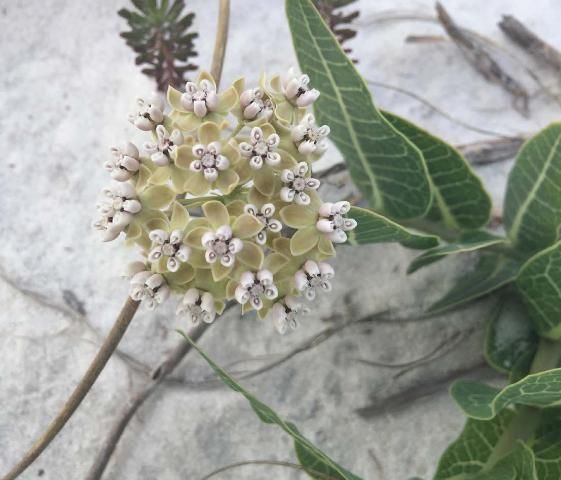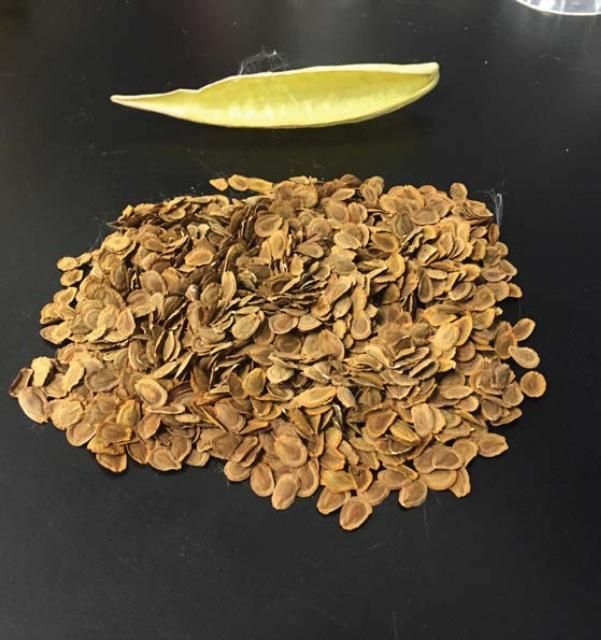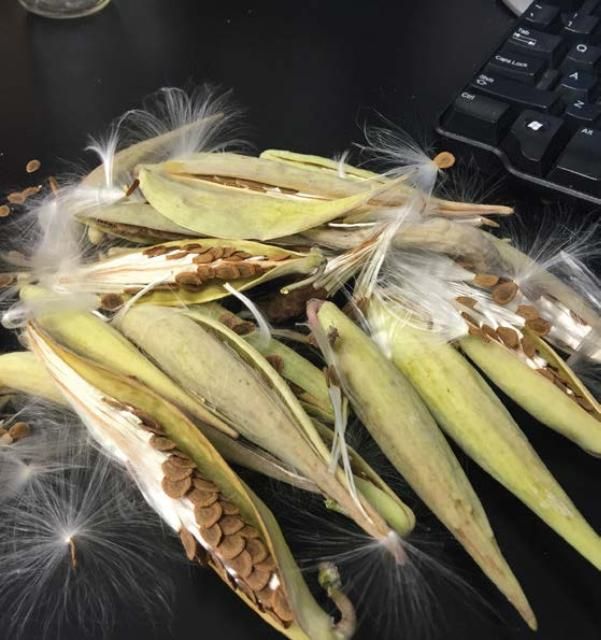Sandhill Milkweed, Asclepias humistrata
Note: This fact sheet is also available as a chapter in a comprehensive manual titled Dune Restoration and Enhancement for the Florida Panhandle, available in pdf form here: https://edis.ifas.ufl.edu/pdffiles/SG/SG15600.pdf. Please see the manual for more information about other useful and attractive native plants for dunes and for further information about restoration and preservation techniques.
Apocynaceae

Credit: Gabriel Campbell, UF/IFAS
Sandhill milkweed is scattered on backdunes, in sandhills, and often in disturbed areas, such as mowed roadsides. It has a range in Florida south to Lake Okeechobee and also occurs in coastal southeast states west to Louisiana and northeast to North Carolina.
The larvae of monarch butterflies are entirely dependent on native milkweeds as a food source for survival, and several studies have identified sandhill milkweed as a monarch butterfly sustainer. Monarchs feed on the leaves of sandhill milkweed, which contain a steroid toxic to predators of milkweeds. Milkweed bugs (Oncopeltus) are also dependent on milkweeds, stalking and feeding almost entirely on milkweed seeds. Several other pollinators, including bees and other butterflies, visit this plant.
General Description
Sandhill milkweed is a deciduous perennial usually less than 3 ft tall. Plants form tuberous (thickened) roots and may become dormant at varied times during the warmer months as well as during the winter. Stems are prostrate to ascending.
Leaves are simple and oppositely arranged. They are "sessile," which means that they lack stalks, and the leaf bases clasp the stem. Leaves are green to green with purple and 2 to 5 in long. Leaves have a glabrous (smooth) surface and prominent pink to maroon veins.
Inflorescences (flower groups) are umbels (attached at a single point like the frame of an umbrella) with white to pink to lavender flowers on pedicels (stalk of a single flower) and occur terminally or in leaf axils during spring to summer with sporadic flowering through fall. Flowers are typical of the genus with calyces and corollas having 5 reflexed lobes; corollas can be up to 7 mm long. Within each flower, pollen is produced and the many grains of pollen fuse together in a special, sack-like structure called a pollinium that is transferred by pollinators as a single unit.
Fruits are follicles 3 to 6 in long containing brown seeds with an attached coma (white, floss-like fiber) that facilitates wind dispersal. All seeds from a single follicle are likely pollinated with pollen from the same pollonium. This plant exudes a milky sap when tissue is punctured.

Credit: Gabriel Campbell, UF/IFAS
Propagation
Campbell (2016) describes sandhill milkweed seed collection, storage, and germination as follows. Seeds should be collected when the follicle is dehisced (splits open) or when it dehisces upon the slight application of pressure, typically with a large seed crop in late May and continuing sporadically throughout the summer. If seeds are not immediately germinated, they should be allowed to air dry for 2 weeks before storage in airtight containers at room temperature. Seeds remain viable for at least 18 months in storage.
Seeds are non-dormant at time of collection with optimal germination temperatures between 24 and 28°C.
Seeds germinate in light but may prefer dark. Viability of seeds is variable but can reach near 100%. Seeds can be germinated with high success in seedling flats. Seedlings have been grown with limited success in 40-cell plug flats, 4-in pots, and 1-gal pots in a greenhouse and outdoors with a standard fertilizer and overhead irrigation. This plant is vulnerable to damping off, aphids, and thrips during greenhouse production and aphids and monarch butterfly larvae during outdoor production. Greenhouse growers report diminishing plant quality after seedlings achieve growth of a few to several nodes.
Though no published cutting propagation protocols are available for Asclepias humistrata, other milkweeds are known for their ability to be propagated from root cuttings (Landis 2014; Luna and Dumroese 2014). Use a well-drained substrate and natural photoperiod to grow this plant. Cutting propagation results in a clonal population and is not recommended for this species.

Credit: Gabriel Campbell, UF/IFAS

Credit: Gabriel Campbell, UF/IFAS

Credit: Gabriel Campbell, UF/IFAS

Credit: Gabriel Campbell, UF/IFAS
Outplanting
Sandhill milkweed is an obligate outcrosser, and, therefore, monocultures (clonal populations resulting from vegetative propagation) for restoration projects are discouraged. Clonal populations may eliminate the potential for outcrossing necessary for seed production. Seedlings (12 months) from 40-cell flats were successfully planted in an outdoor research plot on a historic sandhill pine plant community with over 50% survival. Plant survival was similar after 1 year with or without supplemental fertilizer or irrigation.
Literature Cited
Campbell, G. 2016. "Dormancy and germination characteristics of two Florida native forbs, Asclepias humistrata and Lupinus diffusus." Masters thesis. University of Florida.
Landis, T.D. 2014. "Monarch waystations: propagating native plants to create travel corridors for migrating monarch butterflies." Native Plants Journal. 15(1):5–16.
Luna, T., and R.K. Dumroese. 2013. "Monarchs (Danaus plexippus) and milkweeds (Asclepias species): the current situation and methods for propagating milkweeds." Native Plants Journal. 14(1):5–15.


